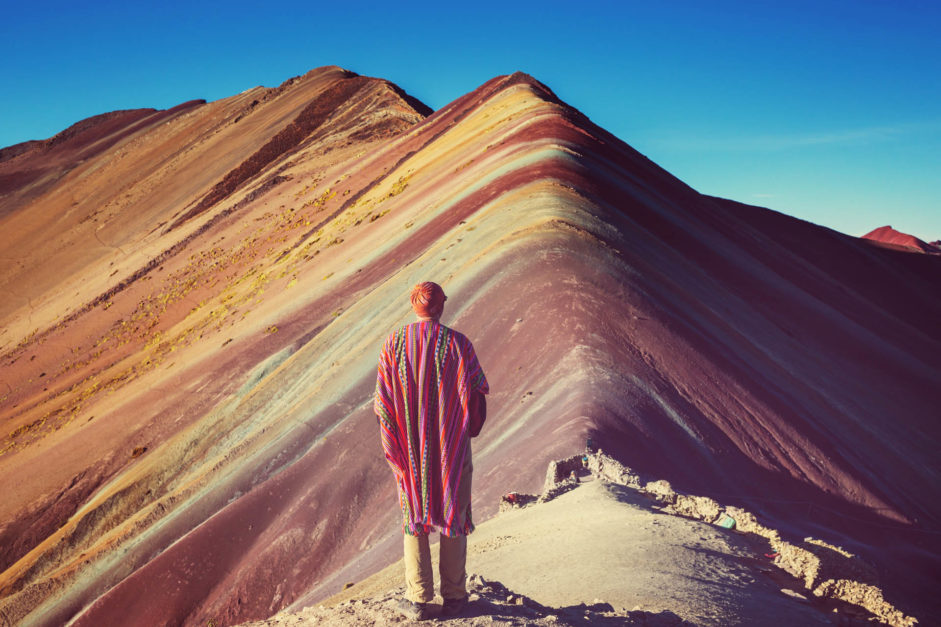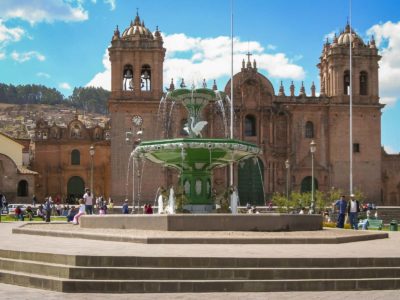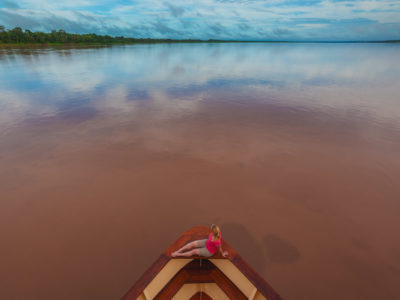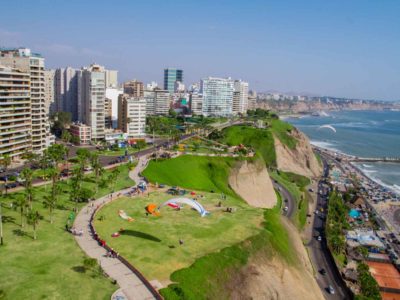It is unsurprising that a visit to Peru makes it at the top of many traveler’s bucket lists.
A country rich in culture, history, and landscape; their cuisine is an epicure’s dream come true, and they house one of the Seven Wonders of the World; Machu Picchu. It’s not expensive, and the country takes the international cake for geographic diversity.
Not only is it home to ancient ruins, it houses the Amazon River, excellent beaches, a vast desert and unique wildlife. When you visit Peru once, you’ll want to go back again and again.
This Peru travel guide will help you plan your next vacation.
Table of contents
Table of Contents
Fast Facts about Peru
- Peruvian power voltage is 200 V 60 Hz; Power sockets A, B & C
- The Peruvian currency is the Peruvian Nuevo Sol (PEN) and is around 1 PEN for 0.33 USD
- Two-thirds of Peru is covered in prime Amazon Rain Forest.
- Bathroom breaks can be quite an adventure in Peru. First off, never ever flush toilet paper down the toilet, it can (and will) clog it, instead always remember to throw everything away in the adjacent trash bins. Also make sure to bring along some extra t.p., wet naps and spare change as many public toilet facilities are pay-to-use.
- The pisco sour is Peru’s national drink and is made using Pisco brandy, lemons, sugar water, egg whites, ice and finished with bitters. It’s really good, try it!
- Fun Fact: Peru is home to the highest sand dune in the world. Cerro Blanco located in the Sechura Desert near the Nazca Lines measures 3,860 feet (1,176 meters) from the base to the summit.
Things to See and Do in Peru
- Visit Machu Picchu – visit the land of the Incas and walk upon the mythical ruins of Machu Picchu for an unforgettable travel experience.
- Hit the waves, dude… – Peru’s waves rarely grace the pages of popular surf magazines, but with 1,400 hundred miles of desert coastline, you can bet that Peru has some amazing swells. The best surf spots can be found in Northern Peru. In fact Chicama (in Peru) has the longest left point break in the world.
- Eat cuy – if you are feeling extra adventurous then why not try cuy or Guinea Pig, a traditional dish eaten in Peru during important festivals, served crispy complete with head, legs and eyes.
- Visit the Amazon – cruise the Amazon river, chat with locals, experience breath-taking sunsets, spot pink dolphins and so much more!
- Visit Lake Titicaca – located along Peru’s border with Bolivia, Lake Titicaca is the largest lake in South America and is also the highest navigable lake in the world with a surface elevation of 3,812 meters.
- Hike Rainbow Mountain – Take an Adventure and hike the colourful layers of Rainbow Mountain.
- Take A Photography Safari – join some of the best photographers in the industry as you embark on a journey through the Tambopata National Reserve looking for that perfect shot.
- Admire the Sand Dunes at sunset – Huacachina is the ideal place to walk up to the top of a dune and watch the sunset over the desert.
- Set sail to Isla Ballestas – known as the poor man’s Galapagos, these islands are part of an amazing conservation area of more than 700,000 acres filled with different types of wildlife.
Peru Travel Guides
Budgeting
Accommodation
Budget – You can stay at budget hotels in Peru for around $20 US. These may include shared rooms, free Wi-Fi, and be close to public transportation.
Mid Range – Mid-range hotels can start around $50 and include private rooms, a restaurant and room service.
High End – Luxury hotels begin at $80 per night and may include a fitness center, spa, and upscale lounge.
- Check out our favorite booking platforms Booking.com, Tripadvisor and VRBO for the best deals on accommodation.
Food
- Papas a la huancaína – A Peruvian staple is golden potatoes covered in a cheese sauce with spices.
- Pisco sour – The national drink is something you must try, which is pisco, egg white, lemon juice, and simple syrup.
- Ceviche – You can find this popular dish in almost any restaurant which is cold fish mixed with lime juice, chiles, onion, and salt.
- Rocoto relleno – These spicy peppers are stuffed with meat, spices, garlic, raisins, and onions.
- Read: 5 Authentic Cusco Restaurants Where you Can Eat Like a Local
The Best Ways to Get Around Peru
Getting to Peru:
Flights: You can fly from European cities such as Madrid, Paris, and Barcelona directly. There are also several direct North American flights including Toronto and Miami.
You can check for the best flights to Peru on Skyscanner.
Transportation:
uses: Buses are available in larger cities, but they won’t always arrive on time or have an obvious bus stop so you may need to ask around. Economic buses are often your only choice within the city and start at 5 PEN, but you can pay more for a luxurious bus when going from city to city.
Taxis/Uber: Taxis are available starting at 5 PEN, but not all of them are regulated. You can look at the roof to find a company number to find a trustworthy one. Uber is available sparsely in bigger cities.
Car Rental: Car rentals start at 80 PEN per day. You can also compare prices here.
When to go To Peru
Peru has a very diverse landscape with deserts, tropical coasts, Amazon Rainforests, and high Andes mountains. Travel and temperatures vary. Peru can be visited any time of the year but here is a breakdown to help you decide what is best for you.
May – October is Peru’s dry season and the best time for hiking the Inca Trail, visiting Machu Picchu, Cusco, and Sacred Valley. July and August are the busiest months and trails are packed. May and October are good shoulder season with good weather and a bit fewer crowds.
May-Oct is also prime season for Amazon Travel: We visited the Amazon late November and while we had a few spots of rain, it was only in late afternoon or evening. It was very hot at this time of year.
You can visit the Amazon any time of the year, just expect more rain and mosquitoes in the rainy season. November – April is the rainy season and mountain passes can be impassable at this time of year. Note: The Inca Trail is closed for the month of February. Feb-April are the wettest months.
Dec – April – This is a good time of year to visit the desert region as it is hot and dry. Any time of Year – The West Coast and Lima are good to visit any time of the year.
Where to Stay in Peru
Novotel Cusco – This Cusco hotel is close to the airport and offers breakfast served in your room for a fee. There’s also a play area for kids, making it great for families that are traveling.
Dazzler Lima – This Lima hotel has a shuttle service available and free parking if you’re driving. They also offer a fitness center and in-room massage services.
Hotel Stefanos – This hotel is close to the airport in Lima as well as the shopping district. They have a free breakfast buffet and a business center as well.
Check out our favorite booking platforms Booking.com, Tripadvisor and VRBO for the best deals on accommodation.
What to Pack for Peru
Peru’s terrain ranges from desert to jungle and mountain to coast. February and March are generally fair everywhere. The mountains tend to be rainy from November to March and the Highlands between October and April. Lima is most humid from June through September and the Amazon is always hot and humid.
- Personal Safety products – Certain areas in Peru are known as pickpocket hotspots. Before leaving for your trip, make sure to pack some personal safety products, like money belts and locks, so that you can keep your valuables safe on your trip.
- Get Medical Insurance – adventure travel is common in Peru, but if you plan on trekking in the amazon; paragliding and/or hiking, make sure to be covered just in case.
- Pack accordingly depending on the season – Peru is split into two periods: the wet (November – March) and dry (April – October) season. During the wet season make sure to pack a rain slicker, jacket or poncho, water-resistant shoes with rubber soles and an umbrella.
- During the dry season, due to the geographic diversity of Peru, travellers might experience a range of different climates depending on region and time of day, so make sure to bring a couple of sweaters or a jacket with a scarf, hat and a pair of gloves.
- Bring a water bottle – water is not potable in Peru, so make sure to pack a water bottle that is easily refillable, especially if you plan on doing any adventure sports!
- Plan for altitude – when hiking to Machu Picchu, you will fly into the town of Cuzco. Cuzco is over 3000 metres (9000 feet) so you will be immediately at altitude. We recommend visiting your doctor or a travel clinic before traveling to Peru to have them prescribe Diamox to help with altitude sickness.
- Pack a hat – The sun can be very hot especially in the desert and the Amazon. A sun hat like a breathable Tilly hat is an important item in your travel gear.
Read our Travel Packing List for our complete packing list.
Peru Travel Guide: Best Booking Resources
Whenever we travel to we make sure to start with these companies. We have tried a lot of different ones over the years and all of these have consistently proven to be the best when it comes to offering great prices.
We have used every one of these personally and continue to do so.
- Booking.com: This is our go site to when comparing prices for accommodation. It usually has the cheapest prices, especially in Europe and we love their interface. Not to mention you get free cancellation and you are guaranteed the best price.
- Trip Advisor: What we like about Trip Advisor is that we can look at all the reviews and then book our accommodation. TripAdvisor is where we go when we want to compare prices with multiple accommodation providers.
- VRBO: is the main search engine we use when we are looking for a home or apartment rental. It can sometimes be cheaper than hotels and it is the best way to stay in areas that offer a more local feel.
- Hostelworld: With one of the largest databases of hostels in the world, Hostelworld is the go-to site when you are looking for budget accommodation.
- Skyscanner: This is the first place we check for flights. It consistently comes back with the cheapest and best options. It allows us to compare a lot of airlines to get the best price.
- Rome 2 Rio: If you want to see how to get somewhere by plane, train, bus, ferry or car Rome2Rio lays it all out for you as well as related costs.I love how they show it all to you on a Google Map and it works offline.
- Get Your Guide: For all your day trip and city guide needs, we use Get Your Guide. It has the world’s largest collection of things to do with more than 30,000 activities in 7500 destinations.
- World Nomads Insurance: When traveling to Italy you should always have travel insurance. We have found the best bang for your buck is by far World Nomads.




